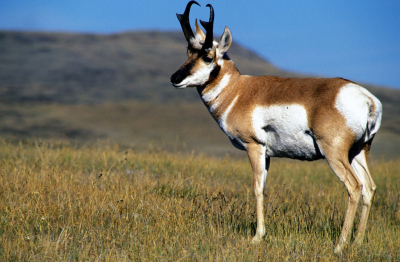
When we think of very fast land animals, the first one that comes to our mind is perhaps the cheetah. Why not? It is the fastest land animal! Do you know which one is the second fastest? The pronghorn. And, the theory behind how it developed such. speed is fascinating. Let's find out more about the animal and its sprinting capacity.
A hoofed mammal, the pronghorn is native to North America, and does not have any close relative anywhere in the world. Healthy populations of the animals exist in their range and are listed under 'Least Concern' in the International Union for Conservation of Nature Red List of Threatened Species. Though it looks a lot like an antelope, the herbivore belongs to its own taxonomic family called Antilocapridae. Pronghorns get their name from the forward-facing projection – the prong on their horns. Interestingly, their ‘horns’ exhibit characteristics of both a horn and an antler. The sheath of its horn is made of keratin, the substance horns are made of. But, these horns are forked and shed every year-just like antlers are! While much can be written about what else is unusual about the pronghorn, its most unique characteristic is its speed.
Running at more than 80 kmph, the pronghorn is the fastest land mammal in its entire natural range- from Canada through the US to Mexico in one aspect, it even gets better than the African cheetah-it can maintain a fast speed for a longer period of time than those carnivores. But the pronghom has no natural predator to match this speed, and so scientists had been stumped by the need for this speed. This is where the science of evolution comes in.
According to a study published recently, during the Ice Age, North America was home to several mammals that no longer exist today. Some of them are well-known today – woolly mammoths, giant sloths, and saber-toothed cats. There were lesser-known ones too, such as ‘Miracinongs’ a cheetah-like cat. The skeletal remains of ‘Miracinonyx’ show that “this now-extinct cat shares the morphological characteristics that indicate high speed capabilities with its African counterpart, the cheetah (Acinony)”. It is a close relative of the puma and the African cheetah. Both puma and ‘Miracinonyx’ are native to North America. Results provide support to "the hypothesis that ‘Miracinonyx’ preyed upon Antilocapra, but not exclusively”. Though it is not seen as conclusive evidence and more study is required, scientists say this "may provide an explanation for why pronghorns are so fast. Maybe they were chased by cheetahs after all".
Picture Crdit : Google




